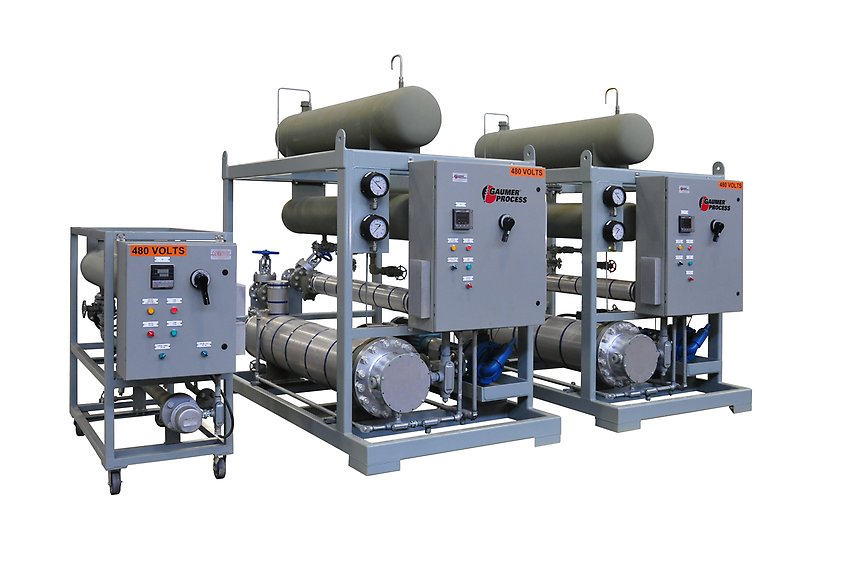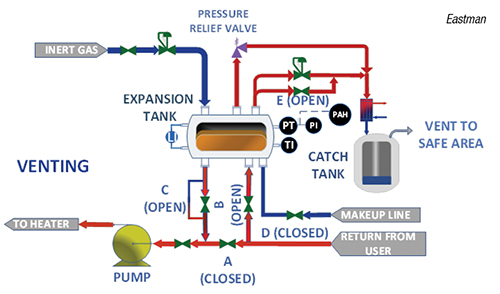Innovations in Heat Transfer Solutions: What You Required to Know for Optimal Efficiency
Innovations in Heat transfer systems are transforming performance across numerous markets. Advanced materials like graphene and nanofluids assure significant renovations in thermal conductivity. The combination of IoT and maker discovering provides opportunities for real-time monitoring and enhanced power efficiency. Nevertheless, the landscape of thermal administration is rapidly evolving (DVS Heat Transfer Systems). Recognizing these advancements is essential for attaining optimal system performance and sustainability in the future. What certain improvements are shaping this change?
Arising Materials for Enhanced Heat Transfer

Advanced Heat Exchanger Designs
While traditional Heat exchangers have actually served their purpose in various applications, progressed layouts are currently emerging to meet the increasing demands for performance and efficiency. These innovative designs, such as plate, shell-and-tube, and finned-tube Heat exchangers, include boosted surface and boosted flow patterns to increase thermal transfer rates. Furthermore, small designs enable minimized area requirements without endangering effectiveness. Advanced materials, such as compounds and corrosion-resistant alloys, furthermore improve longevity and performance under extreme conditions. In addition, simulation modern technologies and computational liquid characteristics are significantly employed to fine-tune these styles, ensuring peak Heat transfer characteristics. As markets look for to reduce energy consumption and maximize output, the adoption of sophisticated Heat exchanger layouts is critical in achieving these goals.
The Function of Nanotechnology in Heat Transfer
Nanotechnology plays a necessary duty in enhancing thermal conductivity within Heat transfer systems. By controling products at the nanoscale, researchers have achieved substantial enhancements in power performance. These improvements not just optimize performance yet also add to even more sustainable power solutions.
Enhanced Thermal Conductivity
Considerable developments in thermal conductivity have actually arised via the application of nanotechnology, transforming Heat transfer systems throughout various sectors. By integrating nanoparticles right into Heat transfer fluids and products, researchers have actually attained remarkable rises in thermal conductivity. These nanoparticles, such as carbon nanotubes, graphene, and metal oxides, improve the Heat transfer homes due to their high surface location and one-of-a-kind thermal characteristics. The resulting composites display enhanced efficiency in applications varying from electronics cooling down systems to sustainable power modern technologies. The capability to customize the size, form, and structure of nanoparticles allows for optimized thermal monitoring services. Consequently, nanotechnology proceeds to play a critical role in the growth of much more efficient and efficient Heat transfer systems, leading the way for boosted commercial applications.
Energy Effectiveness Improvements

Combination of IoT in Heat Transfer Equipments
The combination of IoT in Heat transfer systems introduces the application of smart sensors that boost functional effectiveness. These sensing units enable real-time information monitoring, allowing for instant modifications and optimizations. This technological advancement has the possible to substantially enhance performance and energy management in Heat transfer applications.
Smart Sensors Application
As Heat transfer systems develop, the combination of clever check over here sensors via the Internet of Points (IoT) has actually emerged as a transformative approach. These sensors enable real-time surveillance of flow, pressure, and temperature prices, enhancing system performance and integrity. By accumulating and sending data, they facilitate aggressive upkeep, reducing the danger of system failings. Additionally, wise sensors add to power financial savings by refining operational parameters based upon environmental problems. Their ability to analyze trends and anomalies permits educated decision-making, making certain peak performance of Heat transfer systems. As sectors increasingly adopt this modern technology, the application of smart sensing units stands to revolutionize just how Heat transfer systems are managed, leading the way for greater sustainability and enhanced efficiency outcomes.
Real-Time Information Tracking
How can real-time data monitoring enhance the efficiency of Heat transfer systems? By incorporating Web of Things (IoT) technology, Heat transfer systems can utilize continuous data collection from smart sensing units. This real-time monitoring enables immediate evaluation of flow, temperature level, and stress prices, allowing operators to recognize inefficiencies quickly. Consequently, changes can be made to optimize efficiency, lower power consumption, and expand devices life expectancy. Furthermore, anticipating maintenance can be carried out, reducing unforeseen downtime and expensive fixings. The capability to visualize performance metrics with dashboards improves decision-making, fostering a proactive technique to system monitoring. Ultimately, real-time information keeping an eye on not just improves operational efficiency but also adds to sustainability goals within industrial processes.
Power Efficiency and Sustainability Trends
Power efficiency and sustainability fads are improving the landscape click to read of Heat transfer systems, driving innovation and conformity throughout numerous industries. Organizations are significantly focusing on energy-efficient styles to lower operational expenses and decrease environmental effects. The integration of renewable power resources is coming to be extra widespread, making it possible for Heat transfer systems to operate sustainably while meeting regulative requirements. Additionally, advancements in products and modern technologies advertise reduced power intake and improve total efficiency. Lifecycle evaluations are also acquiring grip, enabling firms to review the ecological impact of Heat transfer systems from production to disposal. This emphasis on sustainability not only sustains company obligation but additionally positions companies competitively in a market where consumers progressively prefer eco-friendly remedies. Subsequently, power effectiveness and sustainability continue to be vital factors to consider for future growths in Heat transfer technology.
Innovations in Thermal Administration Solutions
While the need for reliable Heat transfer remains to climb, innovations in thermal monitoring remedies are arising to resolve both efficiency and sustainability obstacles. Advanced materials, such as phase modification materials and nanofluids, are being developed to improve Heat transfer performance - DVS Heat Transfer Systems. These products enhance thermal conductivity and enable much better temperature policy in numerous applications. Additionally, innovations like energetic thermal control systems are obtaining traction, making it possible for real-time adjustments to handle Heat flow efficiently. These systems contribute to energy savings and minimize the environmental impact of thermal procedures. Moreover, the assimilation of IoT in thermal monitoring facilitates tracking this post and anticipating upkeep, ensuring maximized performance and durability of Heat transfer systems. In general, these innovations stand for considerable strides towards more lasting thermal monitoring methods
Future Directions in Heat Transfer Innovation
Arising developments in thermal administration services indicate an encouraging future for Heat transfer modern technology. Researchers are increasingly focusing on developing materials with exceptional thermal conductivity and improved power efficiency. Technologies such as nanofluids, which contain suspended nanoparticles, offer considerable renovations in Heat transfer efficiency. In addition, the combination of smart products that adapt to differing temperature problems is gaining traction, permitting more receptive and reliable systems. The surge of additive manufacturing strategies is additionally allowing the layout of intricate Heat exchanger geometries that enhance liquid flow. Additionally, the implementation of machine knowing formulas is anticipated to revolutionize the optimization of Heat transfer systems, helping with anticipating upkeep and performance enhancement. Collectively, these developments are positioned to change the landscape of Heat transfer innovations in different industries.

Frequently Asked Questions

How Do I Select the Right Heat Transfer System for My Application?
Selecting the best Heat transfer system entails reviewing application requirements, including temperature level ranges, fluid buildings, and efficiency needs. Assessing system kinds, maintenance factors to consider, and cost-effectiveness likewise plays a necessary duty in making an informed decision.
What Are the Maintenance Needs for Advanced Heat Exchangers?
Maintenance needs for innovative Heat exchangers generally consist of normal examinations, keeping an eye on for leakages, cleaning of surface areas, and guaranteeing excellent circulation prices. Sticking to maker standards assurances reliable procedure and extends the tools's life-span.
Just How Do Ecological Aspects Impact Heat Transfer Performance?
Environmental factors significantly influence Heat transfer efficiency. Variants in moisture, airflow, and temperature level impact thermal conductivity and convective Heat transfer, ultimately affecting system performance and demanding consideration throughout the layout and procedure of Heat transfer systems.
What Safety Requirements Apply to Heat Transfer Systems?
Safety requirements for Heat transfer systems commonly include standards from companies such as ASME and ASTM. DVS Heat Transfer Systems. These standards address materials, style, and operational practices to assure reliability, efficiency, and security against hazards in different applications
How Can I Repair Typical Heat Transfer System Issues?
Troubleshooting typical Heat transfer system issues involves checking for leakages, making certain correct liquid flow, evaluating insulation integrity, and verifying temperature differentials. Determining these variables can assist maintain system effectiveness and protect against more problems.
Nanotechnology plays a necessary duty in enhancing thermal conductivity within Heat transfer systems. Considerable innovations in thermal conductivity have emerged with the application of nanotechnology, transforming Heat transfer systems throughout numerous industries. Advancements in thermal conductivity through nanotechnology have led the method for amazing renovations in power performance within Heat transfer systems. Power efficiency and sustainability fads are reshaping the landscape of Heat transfer systems, driving advancement and compliance throughout numerous industries. The integration of IoT in thermal monitoring facilitates monitoring and predictive upkeep, making sure optimized performance and longevity of Heat transfer systems.